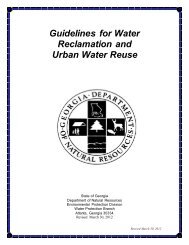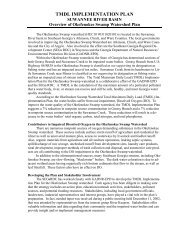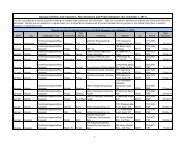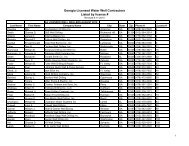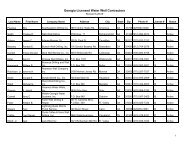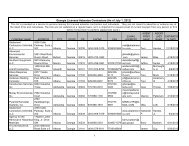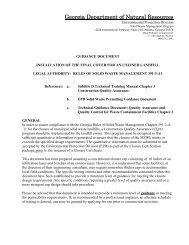River Basin Characteristics - Georgia Environmental Protection ...
River Basin Characteristics - Georgia Environmental Protection ...
River Basin Characteristics - Georgia Environmental Protection ...
Create successful ePaper yourself
Turn your PDF publications into a flip-book with our unique Google optimized e-Paper software.
Section 2. <strong>River</strong> <strong>Basin</strong> <strong>Characteristics</strong><br />
job opportunities created by the manufacture of paper, lumber, furniture and various other<br />
wood products as well as benefiting the consumers of these products. Other benefits of<br />
the forest include hunting, fishing, aesthetics, wildlife watching, hiking, camping and<br />
other recreational opportunities as well as providing important environmental benefits<br />
such as clean air and water and wildlife habitat.<br />
According to the US Forest Service’s Forest Statistics for <strong>Georgia</strong>, 1997 report<br />
(Thompson, 1997), there is approximately 3,429,000 acres of commercial forestland for<br />
the entire counties within the basin. Approximately 62 percent of the total land area is<br />
commercial forest. Private landowners account for 64 percent of the commercial forest<br />
ownership while the forest industry companies account for 33 percent. Governmental<br />
entities account for about 3 percent of the forestland. Forestry acreage in the Suwannee<br />
<strong>River</strong> basin is summarized in Table 2-3. Figure 2-17 depicts silvicultural land use in the<br />
Suwannee basin.<br />
Table 2-3. Forestry Acreage in the Suwannee <strong>River</strong> <strong>Basin</strong><br />
County<br />
Commercial<br />
Forest<br />
Pine Oak-pine<br />
Upland<br />
Hardwood<br />
Lowland<br />
Hardwood<br />
Atkinson 169,900 94,500 11,300 10,600 42,200<br />
Ben Hill 109,500 67,200 16,800 2,300 15,200<br />
Berrien 179,600 90,100 16,300 3,200 64,600<br />
Brooks 189,300 58,900 28,300 30,700 69,300<br />
Charlton 307,100 202,000 41,200 7,300 38,400<br />
Clinch 469,100 309,600 36,400 0 108,400<br />
Colquitt 168,800 81,200 28,900 6,700 36,500<br />
Cook 78,500 30,800 11,300 7,800 27,500<br />
Crisp 68,500 14,700 12,400 7,600 30,000<br />
Echols 242,600 129,800 22,200 7,000 79,400<br />
Irwin 117,500 58,600 24,300 9,500 25,100<br />
Lanier 91,700 48,100 3,700 1,000 35,400<br />
Lowndes 211,900 79,400 35,400 33,500 52,200<br />
Thomas 187,000 68,900 61,900 23,200 33,100<br />
Tift 55,900 19,000 6,300 8,700 20,900<br />
Turner 91,300 53,900 5,400 6,300 16,300<br />
Ware 345,100 228,700 32,400 0 66,400<br />
Wilcox 151,700 87,400 11,300 5,600 40,000<br />
Worth 194,000 94,300 37,600 10,300 44,500<br />
Total 3,429,000 1,817,100 443,400 181,300 845,400<br />
For the period from 1982 to 1997, for the entire counties within the basin, the area<br />
classified as commercial forestland increased approximately 5 percent. The area<br />
classified as pine type decreased approximately 6 percent. The area classified as oak-pine<br />
type increased approximately 55 percent. The area classified as upland hardwood<br />
decreased approximately 21 percent. The area classified as bottomland hardwood<br />
increased approximately 3 percent. Approximately 141,700 acres were classified as nonstocked.<br />
Agriculture<br />
Agriculture is a significant part of the Suwannee <strong>River</strong> <strong>Basin</strong>’s ecosystem. In fact,<br />
agriculture accounts for almost 29 percent of the land use in the basin.<br />
2–24 Suwannee <strong>River</strong> <strong>Basin</strong> Plan



